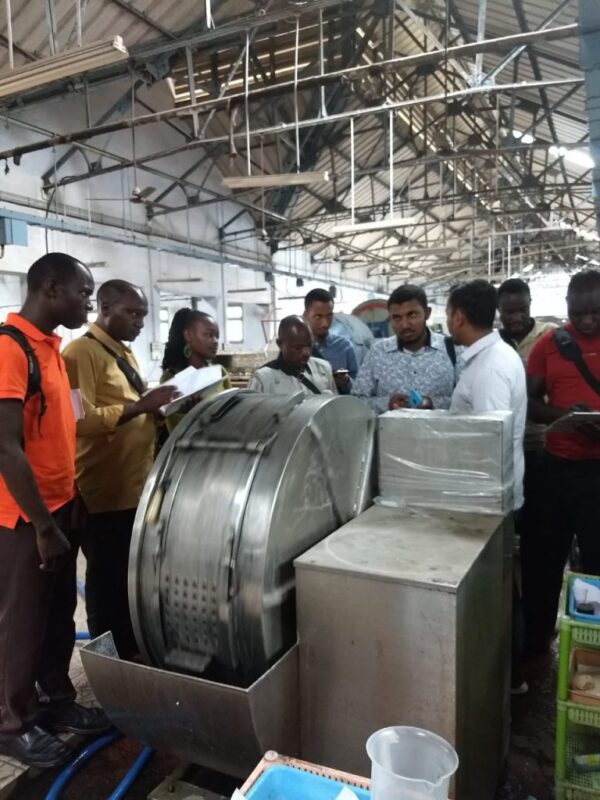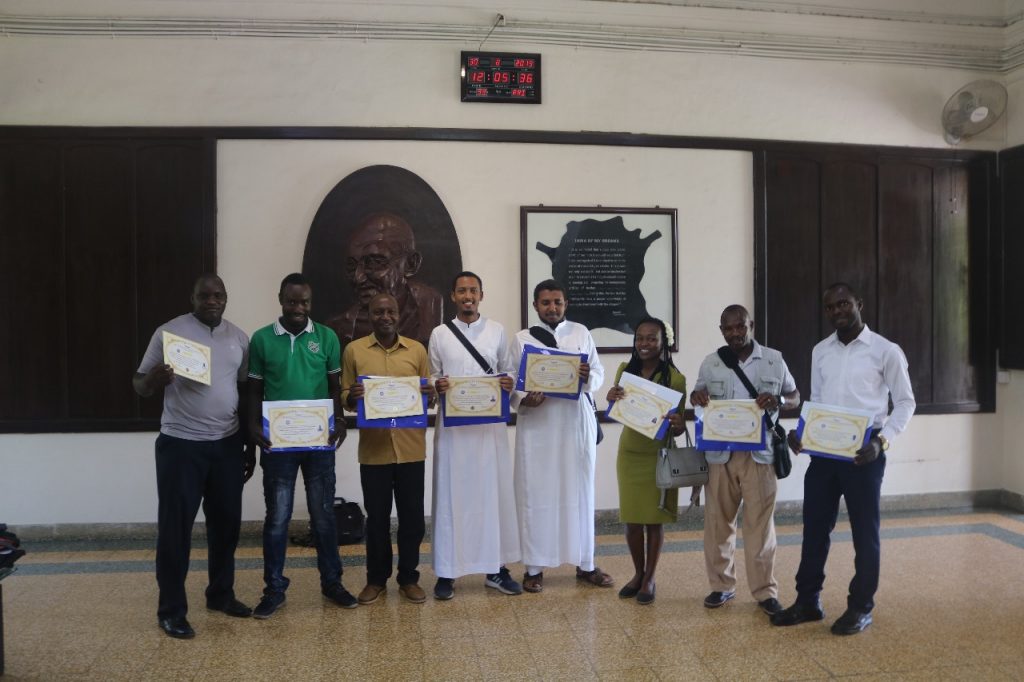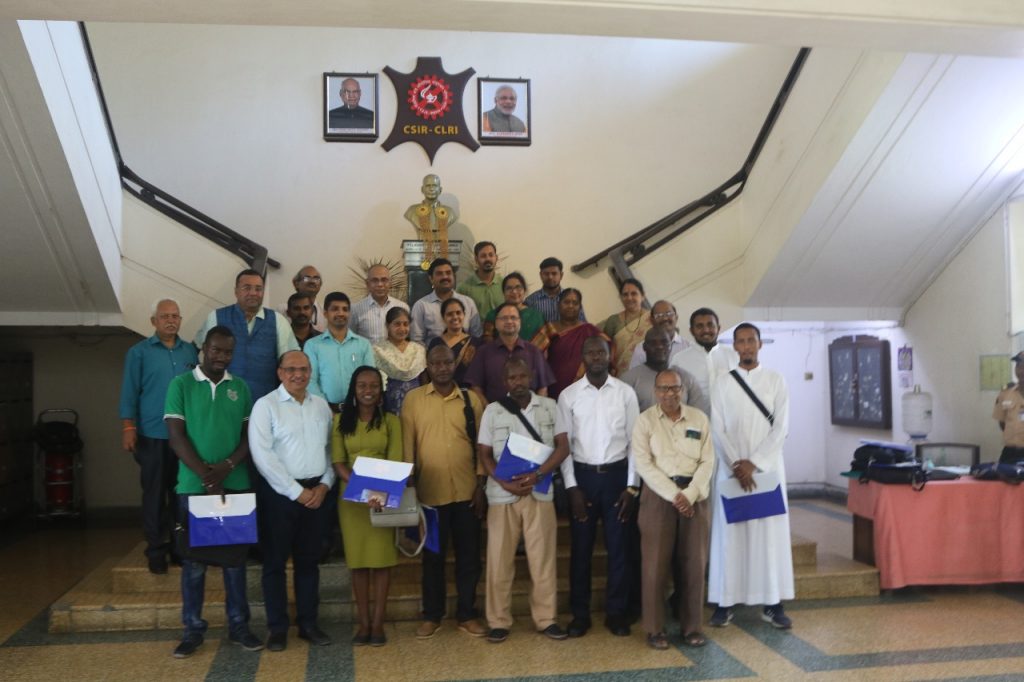Voice of SITA, Voices of SITA
Harvesting the fruits of last year’s South South leather processing training
- Last August, SITA facilitated a four-week training program on Leather Processing Technologies for Leather Manufacturers, which was delivered by the Central Leather Research Institute (CRLI) of India.
- With a focus on value addition for eight East African leather-makers, the training was centered around upgrading wet blue (raw) leather to finished leather, including clean technologies and waste management.
- One year on, all of the six beneficiary tanneries are making strides in taking their processing to the next level.
- Mas Tannery (Kenya) is one such success story. Earlier this year, they started producing and distributing finished leather drawing on skills learnt during the training program in India.
In August 2019, SITA organized a four-week training on leather processing in India.
Teaching both the theory and the practical techniques of upgrading wet blue to finished leather, the training was a game-changer for the East African leather-makers: one year on, one of the beneficiaries, Mas Tannery, has started producing finished leather.
They are not the only ones reaping the benefit of their newfound knowledge: Mas were one of SITA’s six beneficiary tanneries that participated in the trainings. Each tannery nominated a technician to travel to Chennai, India, and undertake the in-depth training.

The importance of value addition
Transforming products from raw material to finished products is game-changing for a business. The reason is simple: value addition. Adding value sustainably, with minimum wastage, and a high-quality end-product allows the company to become more competitive.
It also paves the way for an integrated supply chain, because shoe and leather goods manufacturers can source finished leather locally. This is all going according to plan in the case of Mas Tannery, who reported this month: “we are producing and selling finished leather to the local market, and have reduced export of wet blue.”
The ripple effects are equally as significant. As well as generally being more efficient, regionally integrated supply chains are also more resilient to shocks (like the current pandemic) and they create skilled jobs in the country of origin.
Why knowledge-transfer?
So, what are the barriers to value addition for East African businesses? In most cases, it’s the lack of technical know-how. Not taking advantage of technological advances also holds business back.
Last year’s training for the tanners was designed to address both these barriers head-on. In the case of the six tanneries, SITA identified a knowledge deficit in: processes and operations of tanning, post tanning methods for crusting and finishing; clean technologies; effluent treatment processes; and recycling of tannery waste to make useful by-products.
The course included: different leather processing techniques and methods to store wet blue leather, (for example, cover and keep wet blue leather in the warehouses to retain its moisture before finishing) ; how to use chrome and process control to avoid chrome 6 formation; modern methods to reduce chemical and water consumption; finished leather processing; different types of finished leather and their usages and modern methods of effluent treatment processing. Participants were exposed to specific relevant technologies through field trips to local tanneries, footwear factories, leather goods factories, common effluent treatment plants and facilities making use of waste products.
After the four-week training, the East African technicians returned to their tanneries to turn their knowledge into action. They went on to receive alumni status from the CLRI, which means they can consult their connections at the Indian institute for clarification and guidance on specific queries at any time.

Mas Tannery noted that the training gave them the will as well as the way: triggering their motivation to push processing to the next step, while also providing the sustained support to make it achievable.
The benefits of South-South knowledge exchange
CLRI is a premium leather research and training institute, respected and recognized across the world for their contribution to the industry – particularly in the areas of leather processing relevant to East African tanners. Beneficiaries were exposed to best practices of the leather industry by senior technicians and academics. What’s more, CLRI’s premises house a pilot tannery, meaning teaching was brought to life through demonstrations.
CLRI also has extensive experience in African countries. As a result, Indian leather-makers are well-placed to tailor the course to the specific needs of East Africa. Equipped with this background knowledge and their own comparable past experiences, the student-teacher rapport between the SITA beneficiaries and CLRI was established from day one. The participants themselves were described by their trainers as “inquisitive” and “sincere”.
More of the same!
Meanwhile, the beneficiaries reported having “learnt so many new concepts of leather technology and environmental solutions”. In particular, the participants praised the long duration of the course and hands-on experience of making different types of leather. It meant they came away feeling confident in their new knowledge. Mas Tannery’s recent achievements are testament to SITA’s approach of sustained and targeted support to bring lasting change.

